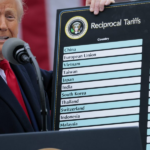China’s central bank opted to keep its key interest rate unchanged as the country prepares for what is anticipated to be a challenging year, marked by concerns over yuan volatility and the distant likelihood of Federal Reserve easing. The People’s Bank of China (PBOC) decided on Monday to maintain the rate on its one-year policy loans, disappointing investors who had expected the first cut since August. Despite injecting more cash into the system to meet funding demands, the central bank refrained from bolder measures following weak credit data released on Friday.
Robert Carnell, regional head of research for Asia Pacific at ING Groep NV, commented on the decision, stating, “In light of the weak data, a cut would probably have undermined the yuan and led to unwanted currency weakness.” Carnell added that the authorities appear constrained in their options, expressing resignation to the likelihood of another challenging year.

Data released on Friday revealed that China experienced its longest deflationary streak since 2009 in December. Additionally, financing and loan growth last month fell short of expectations, and exports recorded an annual decline for the first time since 2016.
China’s government, led by President Xi Jinping, faces challenges such as weak domestic demand, an ongoing property crisis, and a sluggish job market while aiming to achieve ambitious growth goals in 2024. More comprehensive data for 2023 is expected to provide a clearer picture of the economic landscape.
Despite the PBOC’s decision, Chinese stocks traded slightly higher at the mid-day break, erasing losses incurred after the rate decision. The offshore yuan also saw a modest increase of 0.1% to 7.1812, while the yield on China’s 10-year government bonds remained steady at 2.52%.
Uncertainty surrounding the Federal Reserve complicates matters for the PBOC, with the recent acceleration of US consumer prices casting doubt on the possibility of rate cuts as early as March. The growing rate differential between the two economies over the past year adds to the complexity.
Frederic Neumann, chief Asia economist at HSBC Holdings Plc., noted, “The MLF non-cut this morning does suggest there’s not a lot of urgency in terms of adding more stimulus.” He suggested that liquidity injections and credit easing tools might be preferred over an outright rate cut to manage the economic situation.
While the PBOC has encouraged lenders to extend more loans over the past year, efforts seem to be falling short, with data indicating a shift away from risky wealth management products to more stable time deposits.
In response to the economic challenges, a senior central bank official hinted at the possibility of reducing the reserve requirement ratio (RRR), unleashing more money into the financial system. Although not as aggressive as a policy rate cut, a lower RRR could support liquidity and aid banks in purchasing government bonds for infrastructure spending.









